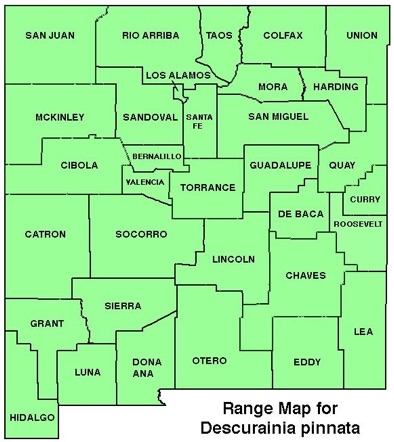WILDFLOWERS OF NEW MEXICO

Growing from a single, branching stem with a base of hairy, fern-like leaves, this is one of the first wildflowers to appear in spring. Heads of tiny, yellow flowers crown the erect, 5–22-inch tall stems. Slender seed pods line the stem as it continues to grow and flower. Note the pods are club-shaped to narrowly-oval with rounded tips and reach 5/8-inch long. Fall germinating seeds over winter as rosettes.
FLOWERS: February–July. Yellow, 4 tiny petals, 1/16–1/8 inch long (1.5–3 mm), oval shaped; flowers clustered on upright head. Siliques (narrow pods), hairless, pointing outward and upward, linear, slightly curved, 3/16–5/8 inch long (4–15 mm); stem of seed pod (pedicel) 3/16–3/4 inch long (4–18 mm).
LEAVES: Alternate. Blades pinnately compound, 1–4 inches long (1–10 cm), smaller towards top, covered with dense, fine grayish hairs. Note the leaflets along midrib are divided into round-tipped lobes (not slender, linear, pointed lobes as in D. sophia).
HABITAT: Sandy, gravelly soils, roadsides, disturbed areas; deserts, sagebrush, pinyon-juniper woodlands.
ELEVATION: 3,600–8,800 feet.
RANGE: Widespread west of Mississippi River and southern Atlantic states.
SIMILAR SPECIES: Two other widespread native species of tansy mustards grow in NM: D. obtusa in the west half of NM has hairy pods when young and leaflets usually with rounded tips; D. incana in the western 2/3rds of NM has lobed leaflets and pods indented to the midrib around the seeds, but not always distinguishable from D. pinnata; D. sophia, introduced and naturalized throughout NM, has slender, linear pods reaching 1-inch long (25 mm) and narrow, pointed, linear leaflets.
NM COUNTIES: Statewide in a wide variety of habitats, especially disturbed soils.

WESTERN TANSY MUSTARD
DESCURAINIA PINNATA
Brassicaceae, Mustard Family
Annual herb



THE CONTENTS OF THIS WEBSITE ARE COPYRIGHTED AND CANNOT BE USED
WITHOUT PERMISSION OF GEORGE OXFORD MILLER

Club-shaped seed pod (silique).
Leaflets along midrib are divided into round-tipped lobes

EMAIL ME